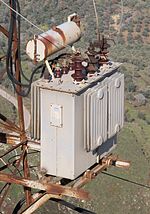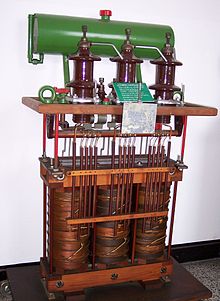- Distribution transformer
-
A distribution transformer is a transformer that provides the final voltage transformation in the electric power distribution system, stepping down the voltage used in the distribution lines to the level used by the customer. If mounted on a utility pole, they are called pole-mount transformers (or colloquially a pole pig). If the distribution lines are located underground, distribution transformers are mounted on concrete pads and locked in steel cases, thus known as pad-mount transformers. Because of weight restrictions transformers for pole mounting are only built for primary voltages under 30 kV.
Contents
Classification
Distribution transformers[1] are classified into different categories based on certain factors such as
- Type of insulation - liquid-immersed distribution transformers or dry-type distribution transformers
- Number of Phases - single-phase distribution transformers or three-phase distribution transformers
- voltage class (for dry-type) – Low voltage distribution transformers or medium voltage distribution transformers
- Basic impulse insulation level (BIL), for medium-voltage, dry-type.
Use
Distribution transformers are normally located at a service drop, where wires run from a utility pole or underground power lines to a customer's premises. They are often used for the power supply of facilities outside settlements, such as isolated houses, farmyards or pumping stations at voltages below 30kV. Another application is the power supply of the overhead wire of railways electrified with AC. In this case single phase distribution transformers are used.
In North American utility practice, single-phase transformers are widely used to power individual homes, while in Europe three-phase transformers are more common, which can supply several buildings. Pad-mount transformers are used in urban areas and neighborhoods where the primary distribution lines run underground. Many large buildings have electric service provided at primary distribution voltage. These buildings have customer-owned transformers in the basement for step-down purposes.
High voltage hobbyists often use these transformers in reverse (step-up) by feeding 120 or 240 volts into the secondary and drawing the resulting high voltage off the primary bushings, using it to power devices like Jacob's Ladders and Tesla coils, and many other high voltage experiments.
Connections
Both pole-mount and pad-mount transformers convert the high 'primary' voltage of the overhead or underground distribution lines to the lower 'secondary' voltage of the distribution wires inside the building. The primaries use the three-phase system. Main distribution lines always have three wires, while smaller "laterals" (close to the customer) may include one or two phases, used to serve all customers with single-phase power. If three-phase service is desired, one must have a three-phase supply. Primaries provide power at one of a wide range of standard voltages from 4 to 33 kilovolts, but the most widely used are 7,200 or 14,400 volts.
Primary
The high voltage primary windings are brought out to bushings on the top of the case.
- Single phase transformers, generally used in the USA system, are attached to the overhead wires with two different types of connections:
- If a primary neutral wire is available, a 'wye' or 'phase to neutral' transformer can be used. This usually has only one bushing on top, connected to one of the primary phases. The other end of the primary winding is 'grounded' to the transformer's case, which is connected to the neutral wire of the 3 phase system, and also earth ground. This type of distribution system, called 'grounded wye', is preferred because the transformers present unbalanced loads on the line, causing currents in the neutral wire. With the 'delta' connection, this can cause variations in the voltages on the 3 phase wires.
- If no neutral wire is available, a 'delta' or 'phase to phase' transformer must be used. This has two bushings on top which are connected to two of the three primary wires, so the voltage across the primary winding is the phase-to-phase voltage. This type is used on long distribution lines where it is uneconomical to run a fourth neutral wire.
- Transformers providing three-phase secondary power, which are used for residential service in the European system, have three secondary windings and are attached to all three primary phase wires. The windings are almost always connected in a 'wye' configuration, with the ends of the three windings connected together and grounded.
The transformer is always connected to the primary distribution lines through protective fuses and disconnect switches. For pole-mounted transformers this usually takes the form of a 'fused cutout'. An electrical fault causes the fuse to melt, and the device drops open to give a visual indication of trouble. It can also be manually opened while the line is energized by lineworkers using insulated hot sticks.
Secondary
The low voltage secondary windings are attached to three or four terminals on the transformer's side.
- In the USA and countries using its system, the secondary is most often the split-phase 240/120 volt system. The 240 V secondary winding is center-tapped and the center neutral wire is grounded, making the two end conductors "hot" with respect to the center tap. These three wires run down the service drop to the electric meter and service panel inside the building. Connecting a load between either hot wire and the neutral gives 120 volts. Connecting between both hot wires gives 240 volts.
- In Europe and countries using its system, the secondary is often the three phase 416Y/240 system. There are three 240 V secondary windings, each receiving power from a primary winding attached to one of the primary phases. One end of the 3 secondary windings are connected together to a 'neutral' wire, which is grounded. The other end of the 3 secondary windings, along with the neutral, are brought down the service drop to the service panel. 240 V loads are connected between any of the three phase wires and the neutral.
Higher secondary voltages, such as 480 volts, are sometimes required for commercial and industrial uses. Some industrial customers require three-phase power at secondary voltages. To provide this, three-phase transformers can be used. In the US, which uses mostly single phase transformers, three identical single phase transformers are often wired in a transformer bank in either a wye or delta connection, to create a three phase transformer.
Construction
The transformers for these are made much the same way smaller transformers are made. Most use a "C" or "E" shaped core made from laminations of sheet steel stacked and either glued together with resin or banded together with steel straps. The low current, high voltage primaries are wound from enamel coated copper wire and the high current, low voltage secondaries are wound using a thick ribbon of aluminum or copper insulated with resin-impregnated paper. The entire assembly is baked to cure the resin then submerged in a large (usually gray) powder coated steel tank which is then filled with high purity mineral oil, which is inert and non-conductive. The mineral oil helps dissipate heat and protects the transformer from moisture, which will float on the surface of the oil. The tank is temporarily depressurized to remove any remaining moisture that would cause arcing and is sealed against the weather with a gasket at the top.
Reference
Categories:- Transformers (electrical)
- Electric power distribution
Wikimedia Foundation. 2010.



